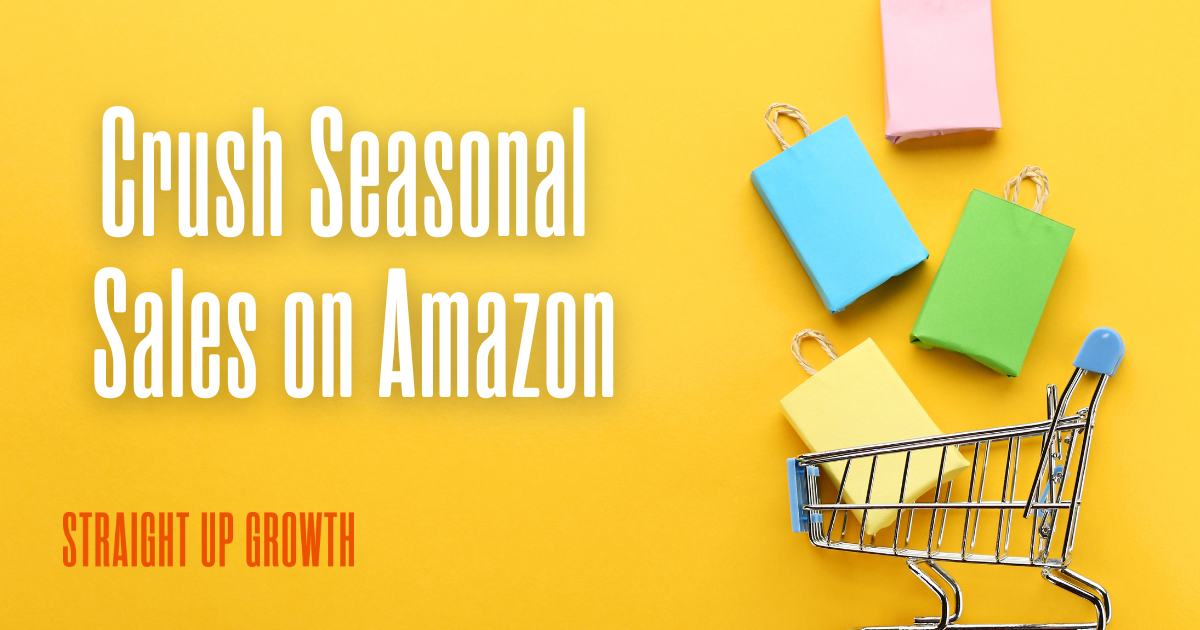Crush Seasonal Sales on Amazon

During peak seasons like Black Friday, Cyber Monday, and the holidays, Amazon experiences huge sales and ad spending spikes. Seasonal products typically achieve higher conversion rates, so preparing well in advance is crucial. It gives you the time to fine-tune your business operations, test different strategies, and ensure your marketing campaigns are fully optimized. By starting early, you can take full advantage of the increased traffic, navigate the heightened competition, and seize the opportunities these key shopping periods offer.
I. Key Seasonal Dates to Watch
Tailor your Amazon listings to holidays, events, and seasonal trends to capitalize on increased consumer demand and to create a more engaging shopping experience. According to Criteo’s Holiday Season Marketing Trends (2022), holiday-themed promotions and visuals increase purchase likelihood, conversion, and improve click-through rates.
Plan your 2025 seasonal content with this list of holidays:
- Winter Holidays: Black Friday, Cyber Monday, Christmas
- New Year & Resolutions: January health & wellness push
- Spring Events: Valentine’s Day, Easter, Mother’s Day
- Summer Sales: Memorial Day, Father's Day, Back to School
- Fall Push: Halloween, early holiday shopping (October/November)
II. Amazon-Specific Promotional Events
Be sure to plan for Amazon's annual promotional events, which include:
- Prime Day (July or October)
- This is Amazon’s biggest event of the year, presenting a massive opportunity for significant sales spikes. Learn more about unlocking Prime Day potential here!
- Fall Prime Event
- A more recent addition, this second Prime-exclusive event in the fourth quarter offers another chance to boost sales during the fall shopping season.
- Spring Deal Event / Big Spring Sale (March/April)
- This emerging event in the spring provides an opportunity to engage customers and drive sales outside the traditional holiday periods.
- Cyber Week (Amazon Black Friday Deals + Cyber Monday)
- Aligning with the broader retail calendar, this week-long event in late November/early December is crucial for capitalizing on holiday shopping.
- Holiday Deals Event (Late November through December)
- This extended period encompasses the peak holiday shopping season, offering sustained opportunities for promotions and increased sales.
Knowing these Amazon-specific events and the general seasonal holidays and celebrations we discussed offers a comprehensive view of when to tailor your content and run promotions to boost your visibility and sales on Amazon.
III. How Brands Should Prepare for Seasonal Dates
Start with promotional planning to prepare for seasonal dates. These times bring massive traffic and eager buyers, which means more chances to make money and promote your brand.
- Time Your Deals Perfectly: Use Amazon's deal event calendar to stay on top of deadlines and ensure your Lightning Deals, Best Deals, and Coupons hit the right moment. This can help increase visibility and drive sales during peak shopping periods.
- Align with Trends: Research trending products and align your deals to match what shoppers are actively seeking.
- Promote Early: Start promoting your deals in advance to build anticipation and early interest.
Next, inventory management should be used for seasonal dates to avoid stockouts during peak demand and minimize storage fees during slower periods. Accurate forecasting, based on historical data and market analysis, ensures optimal stock levels, maximizing sales and profitability.
- Order Early: Get your inventory in early to avoid stockouts due to high demand. Ordering early also gives you a buffer against unforeseen shipping delays, ensuring you’re ready to meet customer needs from the start of the season.
- Stay Alert: Closely monitor Fulfillment by Amazon (FBA) cutoff dates and shipping timelines. If you miss these deadlines, your products can be unavailable for key shopping dates, negatively impacting sales. Stay informed to have your inventory processed and ready for customer delivery.
Also, refresh ad creatives and budgeting for seasonal dates. This helps grab attention when more people shop due to holidays or special events. Boosting ad budgets during these busy times means more people see products, leading to more sales. Changing the ad text and images to match the season and any special deals is also key, making the ads more effective.
- Seasonal Spark: Keep your ads fresh by regularly updating images and text to match the current season. Seasonal visuals and messaging can capture the attention of shoppers actively searching for holiday-themed or event-specific products.
- Boost your Budget: Strategically increase your ad spend during peak times to grab more attention. A higher budget during these periods can maximize visibility by allowing more potential customers to see your ads, leading to increased sales.
- Reach Out: Use Sponsored Brands and Display ads to connect with a broader audience. These ad types can help you reach customers searching for specific products and browsing related categories.
Lastly, prepare marketing materials to capitalize on increased consumer engagement and spending. Seasonal promotions and themed campaigns resonate more deeply with consumers, boosting brand awareness, sales, and customer loyalty. This can allow brands to stand out and maximize marketing ROI during peak shopping seasons.
- Upgrade your Content: Refresh your A+ Content, Storefront, and external channels (email, social) for the season. Updated content ensures that your brand’s message is timely and relevant, capturing the attention of seasonal shoppers.
- Boost Urgency: Use seasonal messaging to create a sense of urgency and make your offers more relevant. Limited-time offers and themed promotions can encourage customers to make purchasing decisions quickly.
IV. Final Tips
It’s best to begin planning 6 to 8 weeks before major events. Start holiday campaign planning early, as many consumers begin shopping in October. Early planning allows for strategic design, A/B testing, adjustments, and efficient execution. Leverage Amazon Brand Analytics and retail insights that can help inform your strategy and grow your business. Lastly, foster collaboration between your marketing, logistics, and creative teams.
V. Q&A: Seasonal Campaigns on Amazon
1. How far in advance should I plan for events like Prime Day or Black Friday?
Start preparing for Prime Day or Black Friday 6 to 8 weeks beforehand. This gives you ample time to fine-tune operations, including inventory, pricing, promotions, advertising, and customer service.
2. What’s the best ad strategy during a seasonal sale?
Begin with keyword research, product listing refinement, and inventory checks to meet potential demand early. Optimize your budget and monitor/adjust campaigns frequently. Learn more with Amazon’s 3-step guide to the peak year-end shopping season.
3. Should I pause evergreen campaigns during seasonal pushes?
It depends on your strategy. Shifting the budget to seasonal campaigns can boost ROI, but consider your evergreen campaigns' consistent performance and audience overlap. Alternatives: reduce the budget or adjust the bids. Test to see what works best.
4. How can I ensure my inventory is sufficient for seasonal demand?
Forecasting and inventory management tools, such as Amazon's FBA tools, monitor inventory levels and ensure sufficient inventory for seasonal demand.
5. When should I start preparing my marketing materials for seasonal campaigns?
Start preparing marketing materials for seasonal campaigns 2-3 months in advance. This allows time for creative development, testing, optimization, and campaign setup before the peak season hits.




